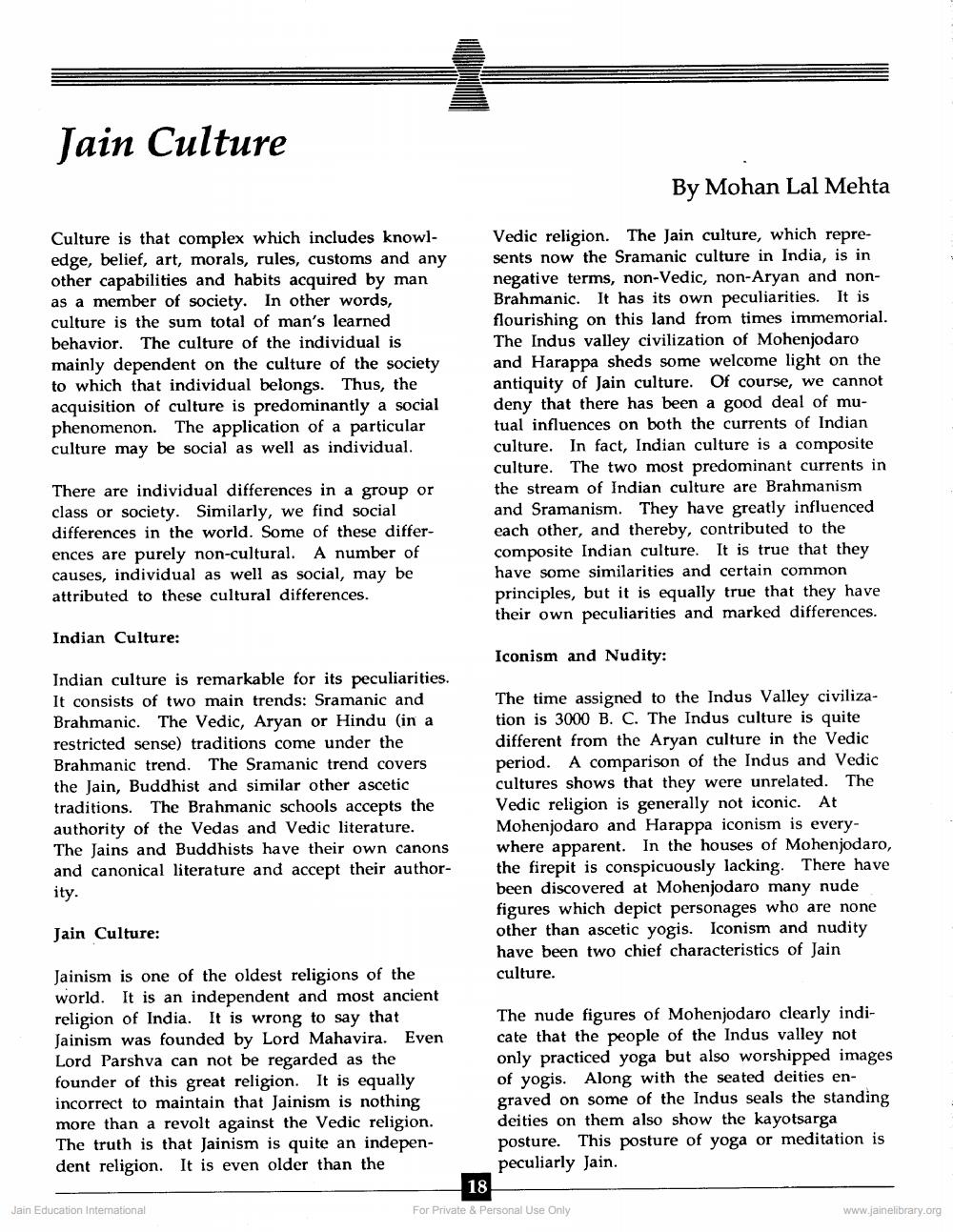________________
Jain Culture
By Mohan Lal Mehta
Culture is that complex which includes knowledge, belief, art, morals, rules, customs and any other capabilities and habits acquired by man as a member of society. In other words, culture is the sum total of man's learned behavior. The culture of the individual is mainly dependent on the culture of the society to which that individual belongs. Thus, the acquisition of culture is predominantly a social phenomenon. The application of a particular culture may be social as well as individual.
Vedic religion. The Jain culture, which represents now the Sramanic culture in India, is in negative terms, non-Vedic, non-Aryan and nonBrahmanic. It has its own peculiarities. It is flourishing on this land from times immemorial. The Indus valley civilization of Mohenjodaro and Harappa sheds some welcome light on the antiquity of Jain culture. Of course, we cannot deny that there has been a good deal of mutual influences on both the currents of Indian culture. In fact, Indian culture is a composite culture. The two most predominant currents in the stream of Indian culture are Brahmanism and Sramanism. They have greatly influenced each other, and thereby, contributed to the composite Indian culture. It is true that they have some similarities and certain common principles, but it is equally true that they have their own peculiarities and marked differences.
There are individual differences in a group or class or society. Similarly, we find social differences in the world. Some of these differences are purely non-cultural. A number of causes, individual as well as social, may be attributed to these cultural differences.
Indian Culture:
Iconism and Nudity:
Indian culture is remarkable for its peculiarities. It consists of two main trends: Sramanic and Brahmanic. The Vedic, Aryan or Hindu (in a restricted sense) traditions come under the Brahmanic trend. The Sramanic trend covers the Jain, Buddhist and similar other ascetic traditions. The Brahmanic schools accepts the authority of the Vedas and Vedic literature. The Jains and Buddhists have their own canons and canonical literature and accept their authority.
The time assigned to the Indus Valley civilization is 3000 B. C. The Indus culture is quite different from the Aryan culture in the Vedic period. A comparison of the Indus and Vedic cultures shows that they were unrelated. The Vedic religion is generally not iconic. At Mohenjodaro and Harappa iconism is everywhere apparent. In the houses of Mohenjodaro, the firepit is conspicuously lacking. There have been discovered at Mohenjodaro many nude figures which depict personages who are none other than ascetic yogis. Iconism and nudity have been two chief characteristics of Jain culture.
Jain Culture:
Jainism is one of the oldest religions of the world. It is an independent and most ancient religion of India. It is wrong to say that Jainism was founded by Lord Mahavira. Even Lord Parshva can not be regarded as the founder of this great religion. It is equally incorrect to maintain that Jainism is nothing more than a revolt against the Vedic religion. The truth is that Jainism is quite an independent religion. It is even older than the
The nude figures of Mohenjodaro clearly indicate that the people of the Indus valley not only practiced yoga but also worshipped images of yogis. Along with the seated deities engraved on some of the Indus seals the standing deities on them also show the kayotsarga posture. This posture of yoga or meditation is peculiarly Jain.
18
Jain Education International
For Private & Personal Use Only
www.jainelibrary.org




